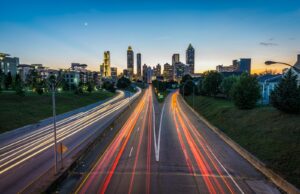NewStart Feature: stadium-led regeneration in Tottenham, catalyst or curse?
 Built in the heart of one of London’s most deprived areas, Tottenham Hotspur’s new stadium has been dogged with controversy, with local businesses and communities feeling like spare balls, as Thomas Barrett reports.
Built in the heart of one of London’s most deprived areas, Tottenham Hotspur’s new stadium has been dogged with controversy, with local businesses and communities feeling like spare balls, as Thomas Barrett reports.
When London mayor Sadiq Khan was shown around Tottenham Hotspurs’ new stadium in January 2018, he was glowing with praise.
‘I welcome the commitment from Spurs in building not just a fantastic stadium for Premier League football and the NFL, but also leading the regeneration of this area of London and investing in local people,’ he said.
With the stadium due to open its doors next season, it will be the culmination of plans announced in 2009 to demolish the current ground and build a brand new stadium on the adjacent land. The new stadium will significantly boost attendance capacity, from 36,000 to 60,000, which the club says will bring in matchday income to allow them to compete financially with Premier League rivals. On the land where the old stadium once stood, 285 housing units were to be built, with 50% being affordable.

The old White Hart Lane stadium
Before the riots
Speaking in October 2009, Spurs chairman Daniel Levy said: ‘We have designed what will be a vibrant area and not a stadium with dead space surrounding it. Our desire has been to create a scheme of major benefit for local people and to deliver the most fan-friendly stadium in Europe.’
Planning permission was granted in 2010 with the condition that £16.7m is spent on Section 106 commitments. In Spurs’ case, this involved stumping up cash for much-needed transport infrastructure.
But in 2011 the Tottenham riots happened, changing the dynamic in Haringey completely.
Suddenly the club had different ideas about its new stadium, and decided that the White Hart Lane rebuild wasn’t financially viable. In 2012, the club received an amended approval from the council which greatly reduced its Section 106 commitments.
‘The club argues that they couldn’t build the new stadium unless they were allowed market rents for the housing units they are building’, says Dr Mark Panton, who recently turned his PhD thesis on stadium-led regeneration in Tottenham into a graphic novel, ‘Tottenham’s Trojan Horse?’.
‘It could be argued this is a massive public subsidy but the football club would argue they are paying for it all themselves and bringing a lot of wealth into the area,’ he added.
Following the 2010 General Election the coalition government altered planning regulations to make section 106 commitments less of a barrier to new developments, creating a perfect storm which many in Tottenham believe allowed the club to renege on their community commitments.
Clubs ‘outsource’ corporate responsibility
In 2015, the London Assembly regeneration committee produced a report called ‘The Regeneration Game‘ which reviewed stadium-led regeneration in the capital.
It said: ‘Local authorities can use stadium-led regeneration schemes to help meet their objectives for local renewal; upgrading the physical environment and delivering social outcomes. A new stadium can also provide increased facilities for community activity, and the chance to co-locate community outreach activities improving the quality and life chances for local people.’
However, in practice, this hasn’t always worked out.
Following their move to the Olympic Stadium, Dr Panton says West Ham have merely paid lip service to the local community. ‘They effectively outsource their corporate social responsibility to their foundations, which are charitable and separate enterprise,’ says Dr Panton.
‘You can’t do that. You can’t just run soccer schools. If the football clubs are causing issues you should be open about it but football clubs are used to not being held to account,’ he adds.
There has been a marked difference in perception between projects such as the Etihad Stadium and its surrounding facilities in Manchester compared to similar stadium-led regeneration projects in London.
For many in the capital, regeneration is synonymous with demolition, with the culture surrounding the projects cagey and secretive.
‘The site in Manchester was one of the most polluted places on earth,’ says Dr Panton.
‘Where the velodrome is now was a power station. What is now the Etihad Campus was an old wireworks. The stadium is built on a coal mine, so there was a lot of reclamation work needed,’ he adds.
Tottenham Hotspur is now the biggest landowner in Haringey after buying up properties surrounding the stadium during the process, giving them unquestionable clout as the years have progressed. Dr Panton believes this was a deliberate ploy to run the area down, so that when a compulsory purchase order came around, the properties would have a low valuation which the council and football club used to their advantage.
Residents mobilising against Haringey plans
In Manchester, the football club had consultation after consultation with local stakeholders, but it has been a different story in Haringey.
At the crux of the new Tottenham development is the social housing estate, Love Lane, due to be demolished which will improve access from the train station to the stadium and provide new housing. But its residents have suffered years of uncertainty, with many decanted from their homes.

Charles House, Love Lane
‘They are promised the right of return and 70% have already left,’ says Dr Panton.
‘The reality is if you move out and you have kids and a job and you have to make a life for years while new buildings are put up and don’t always want to return.’
The Haringey Development Vehicle is a council-led plan for the area which has run alongside the White Hart Lane project, and involves several more demolitions around the ground. It’s been highly controversial, with Labour councillors who support the plan deselected. Community groups in Haringey have mobilised and some of the council’s demolition plans have been put into abeyance.
As part of the Haringey development vehicle, £2bn of money will be spent on a regeneration project that will see the demolition of the Northumberland Park housing estate behind White Hart Lane. Homes, schools, business premises and libraries in the area are proposed to move into semi-private hands, with 50% ownership going to Australian firm Lendlease.

The Northumberland Park estate
Residents are understandably worried that this will mean further destruction of the local community. They have been promised a right to return, but are concerned that the compensation for their demolished homes will not be enough to buy a new home in the area, forcing them to move out of the area that they’ve lived in their whole lives.
Sadiq Khan has promised a resident’s ballot on publicly funded estate regeneration projects, and Dr Panton believes this must be part of an honest conversation between councils and residents.
‘They need to be transparent. Residents are asked vague questions such as “What would you like to see on the estate?”. People say they want smarter, better facilities, then the council use that to say they need to knock it down.
‘If it’s a straightforward vote between demolition and refurbishment, then people would know what they are voting for,’ he adds.
In December 2015 the club put in a revised planning application which upped the number of seats at the new stadium to over 60,000.
This meant the destruction of two listed buildings on the high road, due to be protected under the original 2009 plans.
Parts of one of these buildings, The Red House, which was built in 1850, will be part of a macabre display in a place called the ‘Tottenham Experience’.
‘It seems bizarre to knock something down to have it on display in a museum,’ says Dr Panton.
Evidence of ‘halo’ effect inconclusive
Stadium-led regeneration has been tried in the US since the 1970s and 80s and current evidence is inconclusive on whether stadiums produce a so-called ‘halo’ effect compared with regeneration based on other land uses such as housing or employment.
There is also the question mark over the type of jobs created through these projects. ‘They are not the type the mayor wants for his kids,’ says Dr Panton.
Grant Cornwell, chief executive of the Spurs Foundation, disagrees.
He told SoccerEx in 2016 that the stadium will have a transformative effect on the local community.
‘We are in one of the most deprived wards in the country,’ he said.
‘We have some of the highest rates of obesity and diabetes, unemployment through generations of families, some of the lowest levels of educational attainment. So, building aspirations for young people are a focus for us, for example, we are the first club to offer a Foundation degree.’
With the completion of the stadium approaching its 90th minute, who have been the winners and losers? The club has its new home, but residents are still fighting to carry on living and working in the area.
Manchester City has monthly meetings with residents groups where they discuss problems that might arise from having tens of thousands of people come into the area on a weekend. The club talks about its developments and residents talk about anti-social behaviour issues and other problems.
It remains to be seen if Tottenham can right some of the wrongs of the past and open constructive dialogue with the residents of the area. Clearly, there is a lot of trust to be rebuilt.
With Tottenham, there’s not been much engagement and the stadium has been likened to a Trojan Horse for much more demolition and development,’ says Dr Panton. ‘The council referred to it as a catalyst, but for other people, it was something else.’
‘In Tottenham, they talk about regeneration and bringing the community together, and the community does come together, but in a way that they didn’t envisage. They come together to fight the proposals and come with their own proposals.
‘What I saw in Haringey after the proposals to demolish Love Lane were people weren’t prepared for it, and they couldn’t believe it was happening. They have now got organised. People are establishing links across London.’
There’s a regeneration of community but not in a way that councils expect.’
















